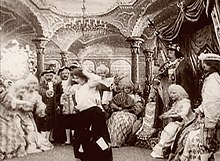Cinderella (1899 film)
| Cinderella | |
|---|---|

A scene from the film
|
|
| Directed by | Georges Méliès |
| Produced by | Georges Méliès |
| Based on |
Cinderella by Charles Perrault |
| Starring |
|
|
Release date
|
|
|
Running time
|
6 minutes |
| Country | France |
Cinderella (French: Cendrillon) is an 1899 French film directed by Georges Méliès, based on the fairy tale by Charles Perrault. It was released by Méliès's Star Film Company and is numbered 219–224 in its catalogues, where it is advertised as a grande féerie extraordinaire en 20 tableaux.
The casts of Méliès's films are in many cases unidentified. Most of the following listing is based on cast identifications made by the film scholars Georges Sadoul, Jacques Malthête, and Laurent Mannoni.
Méliès modeled the film's visual style on the engravings of Gustave Doré, who had illustrated the story for an edition of Perrault's fairy tales. (Doré was stylistically influential across Méliès's career, especially in this film and in his film adaptations of four other works Doré had illustrated: Red Riding Hood, Blue Beard, The Wandering Jew, and Baron Munchausen's Dream.) The direct inspiration for the film of Cinderella was probably a stage adaptation premiered in 1896 by the Théâtre de la Galerie-Vivienne and played by the Troupe Raymond at Méliès's own theatre of illustions, the Théatre Robert-Houdin, at Christmastime of 1897; Méliès may also have been inspired by the Théâtre du Châtelet's lavish 1895 stage production of the story.
Cinderella was Méliès's first film with multiple scenes (tableaux), using six distinct sets and five changes of scene within the film. (His catalogue, by dividing the action into smaller beats, lists twenty tableaux within the film, a generous numbering probably devised for publicity reasons.) So many extras were used in Cinderella that Méliès designated a Chief Extra to lead them.
Cinderella was Méliès's first major cinematic success. It did well both in French fairground cinemas and at European and American music-halls, and inspired Méliès to create other lavishly designed storytelling films with multiple scenes. His next film with multiple scenes, Joan of Arc (1900), was his first to surpass 200 meters of film in length, and was also a marked success. According to the film historian Lewis Jacobs, Cinderella's use of spectacle on screen also influenced the films of Cecil B. DeMille.
...
Wikipedia
